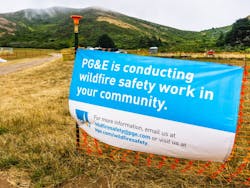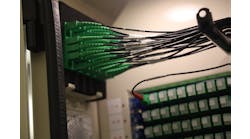Pacific Gas & Electric (PG&E) described partnering with communities on microgrids as “critically important” yesterday following approval by California regulators of the utility’s plan to use microgrids to reduce wildfire-related power outages.
The approval was part of a larger order issued by the public utilities commission to accelerate microgrid deployment statewide (See related story.)
“As PG&E continues our enhanced and expanded efforts to reduce wildfire risks, we are also working to reduce the scope, duration and impact of future PSPS events [power shutoffs]. A key piece of this strategy is developing and deploying microgrids,” said Andy Vesey, Utility CEO and president.
The utility plans to undertake a range of programs, some designed for quick installation to serve immediate reliability needs and other, more complex projects, to unfold more slowly. The aim is to keep the power flowing to groups of customers when the utility de-energizes transmission lines to avoid sparking electrically induced wildfires — a practice known in California as public safety power shutoffs (PSPS).
“While PG&E’s temporary generation program is currently focused on 2020, our work to make the grid safer and more resilient will continue well into the future. Partnering with our communities on customized microgrid solutions for the long term will be critically important,” Vesey said.
Following yesterday’s commission decision, the utility outlined in a statement its plans to make its electric system safer. Besides adding microgrids, PG&E says it will install new grid technology, harden the electric system, and enhance vegetation management.
For 2020, PG&E has reserved more than 450 MW of temporary mobile generators that it plans to use in the following four ways:
1. Substation microgrids: 63 substations will be made ready for connection of temporary generators if the need arises during PSPS events. In addition, PG&E may leverage existing local, permanent power plants, including PG&E’s Humboldt Bay Generating Station and a third-party owned natural gas plant in Red Bluff, California.
2.Temporary microgrids: PG&E plans to rapidly isolate certain areas of communities from the wider grid and re-energize them using temporary generation during an outage. The temporary microgrids will be used in selected communities to energize resources like medical facilities, pharmacies, police and fire stations, gas stations, and banks. Construction is underway at four temporary microgrid generation sites, and PG&E anticipates having 10 sites ready to energize by the end of 2020.
3.Backup power support: This is temporary generation, provided as-needed to critical customers, such as hospitals. PG&E said it is working with the California Hospital Association and Hospital Council of Northern and Central California to identify hospitals supporting the COVID-19 response effort that have a higher likelihood of experiencing a PSPS event.
4.Community resource centers: The utility will places of refuge during the power shutoffs, some with temporary generation to ensure climate control and provide a place where community members can charge devices and receive refreshments.
Partnering with California communities
PG&E also plans to help build multi-customer microgrids, with projects in development by November. Undertaken in partnership with communities, the microgrids will serve local critical facilities or customers with disabilities or functional needs that are not already served by other microgrids.
The utility said that it will help communities design microgrids by providing technical support, improved access to relevant utility information, financial support for qualifying projects, and tariffs to support the accounting for the flows of services, energy, and costs among the parties.
The Redwood Coast Airport Renewable Energy Microgrid project serves as an example of the kind of community microgrid model the PG&E hopes to emulate. The front-of-the meter microgrid is a collaboration between PG&E, the Redwood Coast Energy Authority, Schatz Energy Research Center at Humboldt State University, Humboldt County, Tesla, and others. Expected to be in full operation in December, the project will use solar paired with battery energy storage to serve 18 customers, among them the Arcata-Eureka Airport and the US Coast Guard Air Station. It also will serve as a lifeline for Humboldt County in the event of a natural disaster or other emergency, PG&E said.
“We’ve engaged with a variety of stakeholders on these important efforts, and we look forward to continuing to coordinate and collaborate with interested customers, communities, local agencies, and governments to implement microgrid solutions that build resilience and meet specific community needs,” Vesey said.
Learn more about what’s happening with California microgrids. Watch “Navigating Dual Disasters: What are the Next Steps for California as it Emerges Out of Covid-19 and into Wildfire Season?” from the Microgrid Knowledge Virtual Conference. Featured speakers are:
- Peter Asmus (Guidehouse) research director
- David Erne (California Energy Commission) supervisor, grid integration research
- Tim Hade (Scale Microgrid) COO and co-founder
- Juan Macias (AlphaStruxure) CEO
- Andrea Ruotolo (Worley) global lead, distributed energy systems







